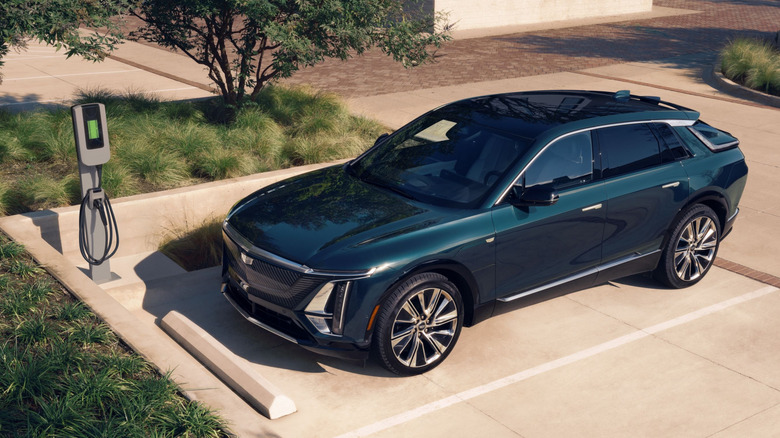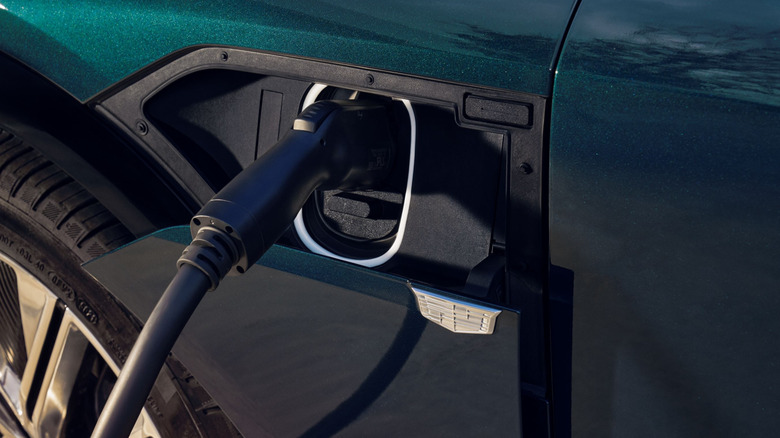Cadillac Lyriq Resale Value: How Much Has The Electric SUV Already Depreciated?
The Cadillac Lyriq has been and continues to be a pivotal vehicle not just for the Cadillac brand but also for General Motors. The all-electric Lyriq crossover SUV was first revealed in concept form back in 2020 and has been at the forefront of Cadillac's transition — or, at least, its intended transition — away from internal combustion and into an all-electric brand since entering production in 2022.
We've had the chance to get behind the wheel of the Lyriq several times over the last couple of years, including during a review of the 2025 Lyriq. We've generally found the Lyriq to be a pleasant vehicle to spend time in, with a spacious cabin, lots of tech, and the refinement you'd expect from a modern luxury EV. But for real-world buyers, it's not just about how a car drives and performs during an extended test drive; it's about the overall ownership experience, and a big part of that is resale value.
With the Lyriq now having been on sale for a couple of years, there's a reasonable amount of data out there on how well it holds its value. And perhaps not surprisingly, given what we know about both used EVs and used luxury cars, the Lyriq's resale value is among the worst in its class.
The numbers aren't pretty
According to Kelley Blue Book, 2023 Cadillac Lyriqs will have depreciated an average of 51%, or $33,000, over the last two years. That puts it in the 75th-100th percentile of depreciation among all 2023 model year SUVs. Not great to say the least. So, what explains this? In Cadillac and GM's defense, many of the issues are less about the Lyriq specifically and more about EVs in general. Depreciation figures are also based on factory MSRP and don't include thousands of dollars in incentives and rebates taken off the price at the time of purchase. For EVs, this can make the numbers look worse than they actually are.
Beyond that, there are two main reasons that EVs have long suffered from high depreciation rates. First, given the pace of battery improvements, an EV that's state-of-the-art one year can quickly feel just obsolete a couple of years later. Second, leasing is still the preferred method of purchase for many EV buyers, and the Lyriq is no exception. Leasing an EV allows buyers to take advantage of incentives and rebates without committing to a long-term purchase of a vehicle that may be considered obsolete in a couple of years. To this point, as much as 75% of Lyriq sales in Q4 2024 were leases rather than purchases, which means that the drivers won't be the ones feeling the brunt of that depreciation.
Depreciation does have its positives
While massive depreciation isn't good for new-car buyers, it does mean that used-car buyers can get a great deal. For example, a brand-new base model 2025 Lyriq might be a hard pill to swallow at $60,000, but a low-mileage, 2023 Lyriq in the low $30,000s instantly sounds a lot more sensible.
It should also be said that resale values of the Lyriq and other used EVs may flatten out or improve after the federal $7,500 EV tax credit goes away in the fall of 2025, because new Lyriqs will be sold at less of a discount. But we'll have to wait and see exactly how losing the tax credit affects the transaction prices of both new and used EVs in the coming months.
Looking at the issue more broadly, strong depreciation and poor resale values have long been, and continue to be, one of the biggest factors standing in the way of electric vehicles winning over more buyers. Sure, some buyers couldn't care less about resale value because they can either afford the hit, are leasing, or plan to keep their car for 20 years or more. But if Cadillac and other brands want to go all-electric, they'll need to do a lot of work to convince other kinds of buyers that EVs like the Lyriq won't plummet in value as soon as they leave the lot.


